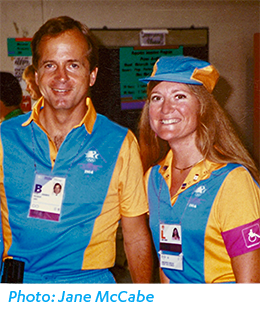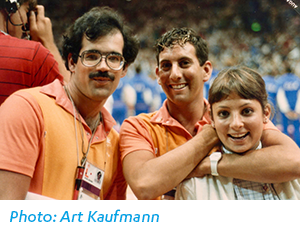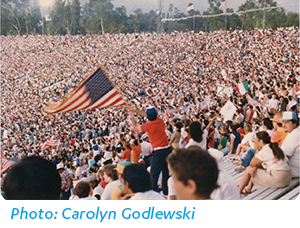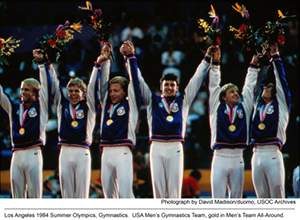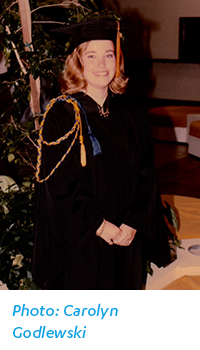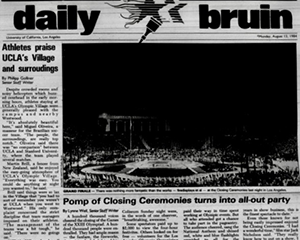 |
|||||||
|
During the summer of 1984 UCLA opened its campus - and its heart - to the Games of the XXIII Olympiad. UCLA’s central location, top notch facilities and space for athletes and spectators made it an ideal setting, and gave Bruins a front-row seat for all the excitement. UCLA was transformed into an international Olympic Village with athletes and visitors from around the world enjoying the best of UCLA. Taking part in this historical occasion created a bond, memories and the pride that comes with a job well done. Los Angeles is currently bidding to host the 2024 Olympics. Once again, UCLA would play a central role in housing athletes, and providing venues and volunteers. We caught up with alumni who were volunteers in 1984, and invited them to share their favorite memories with us. Robin Ann Gorelick volunteered during the games, and a random meeting became her favorite Olympic memory.
I was a volunteer at the 1984 Olympics. I was lucky enough to be assigned to the Journalist’s Box serving water. Driving home from the Olympic Village on San Vicente in Brentwood I saw the New Zealand Cycling Team practicing. They blew through the red light at Barrington and all seven guys were pulled over by the LAPD. I was a second year lawyer (from UCLA Law, of course) so I pulled over and convinced the officers to give them a warning instead of a ticket. Then I rounded up six girlfriends and we took the New Zealand Cycling Team out on the town for three nights straight. They didn't win gold but we had a super fun time.
During the Olympics, members of the UCLA family were well represented - 60 UCLA-affiliated athletes and coaches participated, the largest number from any university, representing the United States and 10 countries. UCLA legend Rafer Johnson ’59, UCLA athlete and two-time Olympic decathlete, carried the torch into the LA Coliseum for the opening ceremonies. Los Angeles Mayor Tom Bradley ’41, UCLA alumni and track star, is credited with the visionary leadership to bring the games to Los Angeles. Bradley remembered watching the 1932 Olympic races through a hole in a fence outside the Coliseum. James Easton ’59 served as “mayor” of the UCLA Olympic Village greeting athletes and making sure everything ran according to plan. Nancy Vos graduated in 1984, working for the Olympics became her first job out of college. I interned with the LA Olympic Committee in 1983-1984 and landed my first paid job at the 1984 Olympics at the Uniform Distribution Center. I interned in several departments. During the games I moved to the Main Press Center at the LA Convention Center and worked for USA Today.
At UCLA, and around Los Angeles, locations were marked with temporary landmarks made of wood and cardboard painted in bright aqua, magenta and tangerine, colors designed for a Southern California feeling. During the games the UCLA Drake Stadium concourse was filled with shops and concession stands with a view of the 142 Flags of Nations lining the field below, the site of daily ceremonies. UCLA residence halls were home to more than 4,000 athletes, coaches and trainers from 62 countries. Pauley Pavilion hosted the popular gymnastics competitions, drawing more than 160,000 spectators. The newly opened Los Angeles Tennis Center, built for the games, held a demonstration tournament. Athletes trained on campus in UCLA gyms, the Wooden Center, Sunset Canyon Recreation Center and Drake Stadium. The Olympic Organizing Committee was headquartered on the ground floor of the James West Alumni Center (JWAC), making it the official entryway to the Olympic Village.
Vito Costanzo was a student worker based at JWAC with a great view of all the action on campus. In 1984, I was employed as a student messenger based at the James West Alumni Center. I graduated that June and soon after came the Olympics to UCLA, where the James West Alumni Center served as the entrance for all the athletes and coaches to the Olympic Village. It was such a festive atmosphere. We had kiosks that greeted the visitors in many different languages and there was always a crowd outside of the center, trading pins and waiting for athletes to give their autograph. I remember befriending a shooting athlete from the country of San Marino and he introduced me to some of his friends. I spent time at the pool with them and they told me about their Olympic experiences. I learned from these athletes that many Olympic competitors are unknown to us because they never appear in the news. Despite the security on campus being very tight, it was a great time to be in L.A. because there was no traffic anywhere. I guess Angelenos were scared off the streets by the thought of Olympic traffic jams. Today I serve on the board of the UCLA Alumni Association and I’m excited about the possibility of the Olympics returning to L.A. in 2024. Jane McCabe worked on campus, volunteered with the games and saw many athletes and events in person. I had the good fortune to be not only a UCLA alumna, but an employee at the UCLA Medical Center in 1984. As an occupational therapist, I was one of the few in the rehabilitation department who had applied and gotten accepted as a volunteer in the Handicapped Services division for the Olympics.
While at Pepperdine University working a water polo event, I saw Peter Ueberroth, the president and CEO of the Los Angeles Olympic Organizing Committee. One of my co-volunteers and I got up the nerve to approach him and ask if he would be in a picture with us. He was kind enough to oblige. Many years later, I met Mr. Ueberroth again at a fundraising event. Knowing he would be attending, I took a copy of the photo with me and had him autograph it! The pageantry of the Olympics would not be complete without a marching band. 125 members of the UCLA Marching Band joined young people from all 50 states as part of the 736 piece Olympic All-American Marching Band. The band played during the opening and closing ceremonies, and band members performed at events throughout the games. The band practiced daily for two weeks in early July perfecting the show, a stirring musical salute to America. Les (Sarff) Taylor played clarinet for four years in the UCLA Marching Band, and auditioned to perform with the Olympic Band.
We spent two solid weeks at Olympic “band camp” at Pepperdine University in July, putting together the complex and elaborate show. Both band directors and personnel from USC and UCLA were heavily involved, including our still-current band director, Gordon Henderson. Once our show was fine-tuned, after long days out on the fields in Malibu, we took road trips to the LA Coliseum to conduct final rehearsals on the actual site where we would soon perform for thousands of attendees and be shown on live television around the world.
But having a bad case of “Olympic fever,” I had concocted a scheme with a bandmate and fellow clarinet friend of mine. Upon exiting with the band, the two of us snuck away undetected into a men’s bathroom, quickly changed out of our uniforms (having packed a garbage bag in our hats so we could store our uniforms) and had shorts and a T-shirt on underneath. This could never happen today, but we talked our way past the ticket attendant and security personnel and walked through a tunnel into the stadium. We sprinted up the Coliseum steps in the random section we chose. Planning for the Olympics started in the early 1970s. Los Angeles mayor Tom Bradley wanted to bring the games to Los Angeles, but local leadership resisted the cost and the possibility of accumulating debt. President of the Los Angeles Olympic Organizing Committee (LAOOC) local businessman Peter Ueberroth was tasked with organizing a debt-free event. He and his team devised a plan for a budget-conscious Olympics. They funded the games with fewer, more lucrative, corporate sponsorships and television deals. Instead of building new structures, existing venues were modified and upgraded. Ultimately, the games were called the most successful Olympics ever, and changed the nature of hosting the games. |
|||||||
 |
|||||||
|
Saul Roe had an insider’s view of the successful structure Ueberroth built from scratch. I worked on the Olympics as a troubleshooter at the Culver City office. I had access everywhere except the athlete areas. The athlete entertainment area at Drake Stadium was designed by the guys next to my office. Although they didn't need help I liked to look at the blueprints of the temporary structures. The Olympics worked because Ueberroth has so much money coming in we could solve any problem with money. Another of Ueberroth’s great organizing successes was eliminating traffic congestion during the games. The committee organized ride-sharing and scheduled deliveries for early mornings ultimately reducing traffic by 20 percent. During the Olympics UCLA launched its vanpool program in a successful move to lessen traffic to campus. This program is a leading example of reducing pollution and traffic while saving money. Caroline Masuda volunteered as a driver, working as much as possible to take advantage of the once-in-a-lifetime opportunity. I volunteered as a driver/escort for athletes and coaches at the Olympic Village at UCLA. I was 19 years old and only had my driver's license for 3 years. I decided to volunteer from early morning to late at night. I stayed close to the UCLA campus by living with my cousin who was going into her fourth year at UCLA Medical School. The dispatching station was the top level of Parking Lot 6, across from the James West Alumni Center. UCLA was not only home for athletes and events, but much of the behind-the-scenes work of producing the Olympic experience happened on campus. Spaulding Field was used by ABC television, which had won the television rights for the 1984 games. Ackerman Student Union housed the press corps, and LAOOC headquarters were on Le Conte, later given to UCLA and renamed the Peter V. Ueberroth building. Art Kaufmann’s UCLA friendship opened the door to a great opportunity during the Olympics.
I graduated with my B.S. in 1981. That fall, one of my friends from the UCLA Band, Joel Fierberg, went to work for Event Management in Athletics and got me and his brother Ira jobs running the scoreboard for UCLA Women's Basketball games. Dr. Judith Holland was the Women's Athletic Director. In 1984 Dr. Holland went on to be the competition director for the 1984 Olympic basketball venue.
There was a serious carryover from the 1976 Olympics -- if you recall, we boycotted the 1980 Games in Moscow. In 1976 there was confusion at the end of the game about whether a basket was scored as time ran out. In order to back up the floor officials, we trained so that two of us were watching the game while the third one watched the clock and counted it down out loud. Fortunately, there wasn't a close call in this game!
When it came to the athletics competition, Bruins experienced great success. UCLA students and alumni won 17 gold, 14 silver and six bronze medals – 41 in all. UCLA students Peter Vidmar ’83 and Mitch Gaylord, and UCLA alumni, Tim Daggett ’86, were part of the first-ever gold medal U.S. Men’s Gymnastics Team, winning the gold over China in an surprise victory. Gaylord won gold on the rings with a perfect 10. Vidmar won gold on the pommel horse and silver in the men’s all-around competition. In track and field, Evelyn Ashford set the Olympic record in the 100-meter at 10.97 seconds. UCLA students have competed in every Olympics since 1920, except the 1924 games, and won 261 Olympic medals, more than half gold, though not all for U.S.A.
Carolyn (Jensen) Godlewski attended events through her volunteer position working with local schoolchildren. In November 1983 I was asked by UCLA administration if I would like to serve as a “Student Liaison” for the Grow with the Olympics Student Program. The Student Olympic Committee was looking for a total of 25 college students to serve as liaisons between the Los Angeles Olympic Organizing Committee and local junior high schools. I believe I was chosen for consideration because I was the Mortar Board president.
Stunning feats of athleticism, record-breaking ticket sales and an unprecedented financial surplus made the 1984 Olympics an unequivocal success. UCLA played a central role in this historic event and, in addition to Olympic medals, Bruins came away with lasting memories and good vibes for a lifetime. Los Angeles is in the running once again to host the 2024 games. The committee is planning ahead, and already putting out a call for volunteers. Sign up early for priority assignments, and the chance to make your own memories of a lifetime. https://la24.org/volunteer | |||||||
|
|




